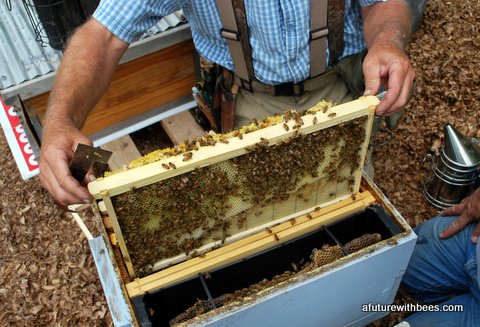Getting your first package this spring? Here is a week by week guideline for managing your new package of bees through their first 8 weeks.
Here is a week by week accounting of the colony's growth. This assumes you have received your bees and installed them in the hive
A couple of general links to help you get started How To Light My Smoker and Spring Planning

General Thoughts:
"Working bees is as much art as it is science" This is important. Bee are living creatures - they do not behave in strictly predictable patterns. So, often our answers start with "Depends on......". It can be as rewarding, and as frustrating, as raising children or horses or dogs. Learn to listen to them and work WITH THEM. This is a relationship (yes it is that complicated), not a dictatorship. Work with your bees, not at them and things will go much smoother for both of you.
Warning: we need to be aware of, and talk about, potential problems. However, don't let them discourage you. Stay focused on the positive! Most packages grow and prosper just fine. Problems are definitely the exception, not the rule.If we talked about all the problems that might happen to your child (autism, broken arms, bad people, birth defects, possible diseases) it could easily scare you away from ever having children! Instead, focus on the positives and be aware of the potential for negatives. Hope for the best and plan for the worst! We need to be aware problems so we can address them if they happen. If you suspect a problem, contact your mentor. They will help you address it.
The packages will need to be fed. Decide how you want to feed them.
Feeder styles: Pros and cons of each
- Jar – use a boardman feeder style at entrance, or the hole in the inner cover, use a mason jar, coffee can, , etc. Pro: Easiest to use and cheapest option. Con: takes an extra deep to cover the jar to work best.
- Frame/division feeder. Pro: in hive feeding. Very versatile. Easy to fill. Bees can drown if not properly set up. Con: takes up space in the hive. Relatively expensive per hive.
- Top feeder. Cons: Heavy and needs to be removed every time you look in the hive. Very expensive on a per hive basis. Pro: holds a lot of syrup and the bees can’t drown if set up properly.
- Don't use an open feeding method. Weak hives don’t gain from open feeding. Can promote robbing. Don't invite bees from nearby colonies to discover the weak package and rob them. Open feeding is for large scale beekeepers with different goals and different loss/gain ratios.
- Do not use medicated syrup! Adding antibiotics for no reason is senseless. Add medications IF you see a symptom that needs to be addressed. You don't medicate your kids every month “just because” do you? Besides adding antibiotics when there is no malady builds up resistance to the medications and harms the bee's immune system.
Week 1:
The week after hiving your bees
Weather and floral conditions: Often cool during the days and near or below freezing at night.
What the Bees are doing: Huddling for warmth when cold. Consuming syrup or nectar when warm and building comb. Queen is “pushing” them for more cells to lay eggs.
What the beekeeper is doing: Feeding. Reducing the entrance. Keeping the screened bottom closed off.
- Make sure to remove the Queen cage 2-3 days after hiving to avoid the comb between the frames. Open the hive, remove the queen cage and push the frames back together. Don't do anything else.
- The book advises waiting a week. I find this is too long for queen cage removal. It is about right for the first inspection.
- Check the piece of comb for the queen.
- Removing bees from the burr comb
- They will usually have 1-2 frames partially drawn, depending on various factors; weather, amount of feed, genetics, quality of equipment, robbing.
- Potential problems (don't get overwhelmed by this!)
- dead queen
- death by cold
- absconding
- do not assume the colony is queen-less because you can't find brood
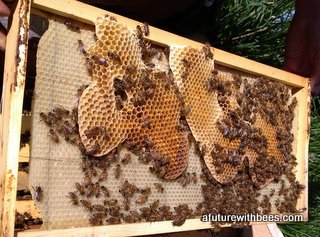
This is what can happen if the queen cage is left in too long. The bees build an extra comb between the frames where the queen cage hangs. This is difficult to clean up.
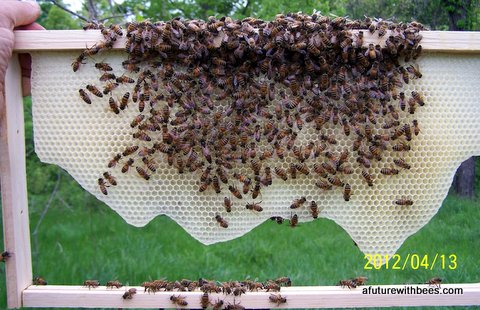
A partially drawn frame with fresh, white wax. The queen is in the lower left quadrant.
Weeks 2 and 3:
Weather and floral conditions: weather is still very variable. Can be cold and rainy or it could be hot and clear. Watch the weather and roll with punches. Many things in bloom now including shrubs and small trees like hawthorns and crabapples. Nectar flow is strong now.
What the Bees are doing: Eating. Building comb.
Queen is laying in whatever space is available to her. There won’t be capped pupae yet.
What the beekeeper is doing: Feeding. Leaving the girls alone for the most part. Do a brief inspection each week only to make sure everything is normal.
- Feeding
- Should have 4-6 frames drawn. If there are less, consider the quality of the package or queen.
-
If using plastic foundation, this may be normal. They grow much slower on plastic foundation (use natural wax!).
-
What are you going to see?
- Lots of bees.
- Don't expect full frames of capped larvae!
- Frames being drawn out.
- Open nectar/syrup in cells.
- Pollen.
- Brood. Eggs. Open Larvae.
- Watch for queen cells.
- Dead bees. Bees die and are born everyday. A few dead bees is normal. Piles of bees is not.
Potential problems:
- • Queen-less. No eggs or brood. Not drawing foundation readily.
• poor queen. Few eggs/brood. Poor pattern. Not drawing foundation readily.
• Supercedure of the queen (swarms often do this. A package is an artificial swarm)
• death by cold (not likely)
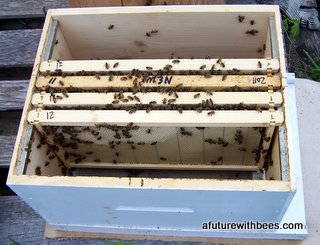
A package 1-2 weeks into the season. The extra frames were removed so you could see the partially drawn foundation on this frame.
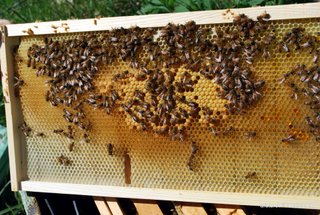
A typical, partially drawn frame in about week 3. There is a small patch of sealed brood in the center. It is surrounded by open larval brood that has not been sealed yet. The queen is laying in the cells as fast as the workers can build them!
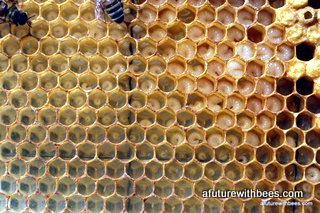
This close up shows all three stages of brood: egg, larvae, and sealed pupae. The eggs are hard to see in the lower portion. The age progression of the larvae from younger and smaller, to older and larger, and then to sealed pupae is easy to see.
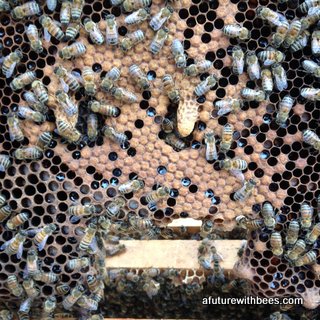
This is a queen cell. If you see these, call your mentor immediately.
Week 4:
Weather and floral conditions: The weather is usually more stable by now. Although it is possible to have frost in lat April. We had snow the first week of May in 2014(?). Many, many things are in bloom now. The nectar flow is near peak for the year.
What the Bees are doing: Population is starting to expand because new bees are now being born. So their rate of work increases. Gathering lots of pollen and nectar.
What the beekeeper is doing: Possibly opening the entrance a little. Keep the screened bottom closed. Still feeding? Considering adding a second box.
- Keep feeding. Keep feeding until there are 8 frames fully drawn. After this, you can decide whether to keep supplying feed or not.
- There should be 4-8 drawn frames. Normally around 4-5 (8 is exceptional!)
You should see:
- Open nectar, capped honey.
- Pollen.
- Brood. Eggs. Open Larvae, sealed Pupae.
- Evaluate the brood pattern
- Add another box? Maybe, maybe not. Depends on how much they have drawn and how strong they have become.
- What type of box to add. Depends on your management strategy. Add a deep or a medium – it really doesn't matter. The bees will use whatever space you give them
Potential problems (don't get overwhelmed by this!)
- Ask the mentor!
- Poor queen. Replace if necessary. Evidenced by poor brood pattern and the bees not readily drawing comb.
- Supercedure. Watch for queen cells.
- What to do? Contact your mentor.
- Option a: boost the package and let them raise another queen (it will be hard to stop them once their “mind” is set)
- Option B: get a new queen and introduce her
- What to do? Contact your mentor.
- Drone layer
- Need to replace the queen asap.
- Get one from a local supplier
- Order a new queen if necessary
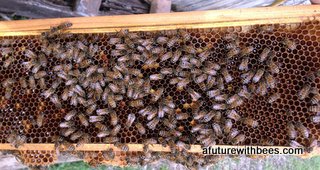
This frame has nectar and pollen in it. The nectar is the shiny liquid reflecting the light. The pollen is the orange-ish stuff that looks like wet sawdust. Pollen comes in many, many different colors including pale gray, bright red and even bright blue!
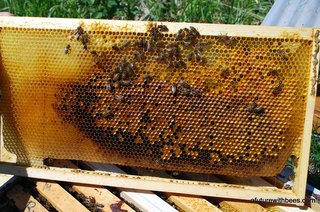
You may start to see frames like this on the outside edge of the broodnest. This is a frame of pollen used to feed the larvae (open brood) before they turn into pupae (closed brood) and molt into full adults
Week 5:
Weather and floral conditions: Early May. The weather is usually great. Everything is in bloom! Nectar flow is at it's peak.
What the Bees are doing: New bees are hatching every day now. The population is growing amazingly fast. Bees are working in overdrive! Raising more bees, gathering nectar and pollen, and building more comb.
What the beekeeper is doing: Adding more boxes when necessary. Manipulating combs. Keeping the screen closed.
- Keep feeding. Keep feeding until there are 8 frames fully drawn. After this, you can decide whether to keep supplying feed or not. The packages that I quit feeding did better that the ones that I fed constantly. Once the colonies population starts building, they do better on nectar than sugar syrup.
- Keep the screened bottom closed. Screens are for varroa control, not ventilation. They work to control varroa even when the slide is in place. Packages do not need an open screen – they are small and weak. Don't make life harder on them by opening the screen bottom until temperatures get over 95 degrees.
- Try to keep in mind a bee's “room temperature” is 92 degrees! Not 72 like you and me. We're mammals, they're not. They are insects and we need to be mindful of that difference. They feel cool when we feel hot. Don't try to ventilate their hives.
- They can manage their temperature regime much better than we can. Leave that screen closed.
- Should be seeing 5-9 frames drawn out. 3-4 of these should be brood. If not, there may be a poor queen.
- The first new bees will be hatching this week. So the population will start increasing rapidly. This means the amount of work they can do will increase as well. Growth from here on out should be good. The population will grow by 1000-1500 bees a day!
- Most problems should have been evidenced and addressed by now. If a package is not performing well (less than 3-4 frames), it is time to consider taking action. This could mean re-queening and boosting, or combining
- The weather should be much warmer now. So we can safely add another box if we haven't already. There is no problem adding extra space now because they do not have the heat retention problems they may have had in the past few weeks. Too many boxes too early is a problem. But for May and June, there is no problem having an extra box or two on the hives.
- When you add another box, pull two drawn frames up into the middle of the second box. Replace the frames that were pulled up with frames of foundation. This will get them to come up into the new box quickly and to draw more foundation out.
- What type of box to add? All box sizes are good. Add a deep or medium depending on your management style.
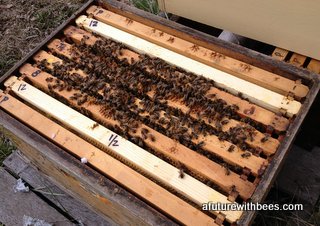
Hopefully the packages are starting to look like this or better!
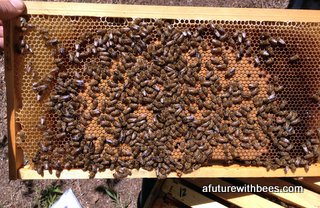
Some frames will start to look like this. A frame of brood with a nice pattern. The sealed pupae are in the middle, open cells with larvae are in a ring around the sealed brood. Fresh nectar can be seen shining in the outermost cells.
Week 6:
Weather and floral conditions: Usually steady, warm weather now with lots of high pressure systems. Nectar flow is at it's peak. Hundreds of species in bloom now!
What the Bees are doing: Same as last week. Bees are in overdrive! Thousands of new bees hatching everyday! They will fill all available comb with brood or nectar. Hives should be booming with bees by now.
What the beekeeper is doing: Open the entrance a little according to how strong the colony has become. Add boxes if they using all available space. Our job is to make sure they have enough room. Manipulating frames to get foundation drawn out.
- Should have 7-13 frames drawn.
- Keep feeding? Probably not but it's your choice.
- Add another box. If it hasn't been done already.
- Pull two drawn frames up into the middle of the second box. (Manipulate the frames when you add another box)
Week 7:
Weather and floral conditions: Pretty much a copy of last week.
What the Bees are doing: The colony's size can easily double now that all these bees are hatching. They are still in overdrive. This is their busiest season of the year! They know they have to get everything collected and stored for the rest of the year before the nectar flow stops in July. They need to collect an entire year's supply of stores in the 3 months of April, May and June! Think about that – really think about that....
What the beekeeper is doing: Mostly keeping an eye on things and making sure they have enough room.
- Should have 9-16 frames drawn.
- Hive is growing. Unless there is a problem, there isn't much management needed.
- Queen problems should have been fixed by now.
- Unlikely to need another box yet. If they do have 16 frames drawn, there will be some frame manipulation.
Week 8:
Weather and floral conditions: Near the end of May here. The nectar flow has peaked and slowly declining. It will continue slowly taper off over the next 6 weeks or so. There is still tons of nectar flowing. Late spring flowers are blooming.
What the Bees are doing: Population is still increasing. They are still frantically collecting nectar and pollen, raising new bees. As the nectar flow slows, comb building will slow. (this is why we need to manipulate frames and get as much drawn as possible. They will most likely stop building comb by mid June). They will be capping fresh honey now. Possibly even making surplus!
What the beekeeper is doing: Same as last week. Managing space. Adding boxes if necessary. Manipulating frames.
- Feeding is unnecessary unless the hive was performing poorly before. The bees should be self sustaining by now.
- Manipulate frames to get foundation drawn.
- Move drawn frames over to the edges and put foundation next to the brood frames (positions 6&7 generally)
- Add another box.
- Move two frames up into the middle of this box. Replace the two frames that were pulled up with foundation
Potential problems (don't get overwhelmed by this!)
- Supercedure
- Disease – not likely. If concerned, ask a mentor.
- Ethical package/nuc producers are not going to send diseased bees.
- We will discuss these possibilities later in the year at the monthly break out sessions. It is counterproductive to add more information to our already overloaded brains at this point unless necessary.
- Robbing. Possible, not likely. Keep the entrance reducer in place.
Coming Soon:
Yearly calendar showing monthly duties for the beekeeper and monthly activity in the hive. First 3 months are ready. This is a work in progress.
Final thoughts:
REMEMBER: "Working bees is as much art as it is science" This is important. Bee are living creatures - they do not behave in strictly predictable patterns. So, often our answers start with "Depends on......". It can be as rewarding, and as frustrating, as raising children or horses or dogs. Learn to listen to them and work WITH THEM. This is a relationship (yes it is that complicated), not a dictatorship. Work with your bees, not at them and things will go much smoother for both of you.
- Learn how to light a smoker so it stays lit for the whole day.
- Learn how to approach an open a hive.
- We teach these skills at field days. Go out with an experienced beekeeper before you get your packages!
Here is a great set of videos to help you assimilate and understand all of this information: Keith Delaplane videos. University of Georgia Center for Continuing Education. Excellent set of videos. Too much medication but generally sound. Don't pull frames from the middle of the colony like he does though. He can afford to roll queens, we can't!
#savethebees #bees #afuturewithbees
